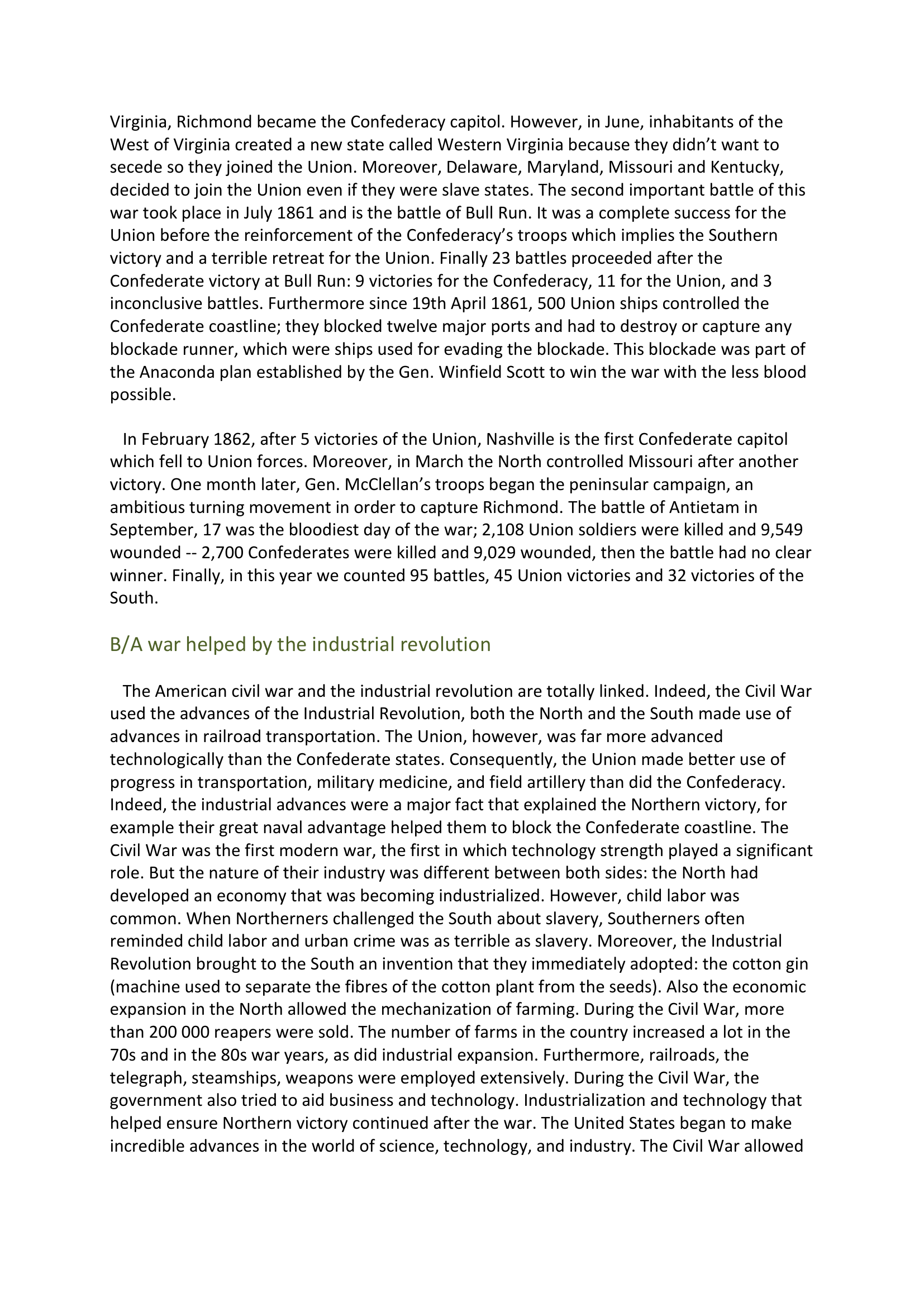American Civil War
Publié le 19/01/2012

Extrait du document
«
Virginia, Richmond became the Confederacy capitol.
However, in June, inhabitants of the
West of Virginia created a new state called Western Virginia because they didn’t want to
secede so they joined the Union.
Moreover, Delaware, Maryland, Missouri and Kentucky,
decided to join the Union e ven if they were slave states.
The second important battle of this
war took place in July 1861 and is the battle of Bull Run.
It was a complete success for the
Union before the reinforcement of the Confederacy’s troops which implies the Southern
victory an d a terrible retreat for the Union.
Finally 23 battles proceeded after the
Confederate victory at Bull Run: 9 victories for the Confederacy , 11 for the Union , and 3
inconclusive battles.
Furthermore since 19th April 1861, 500 Union ships controlled the
Con federate coastline; they blocked twelve major ports and had to destroy or capture any
blockade runner, which were ship s used for evading the blockade.
This blockade was part of
the Anaconda plan established by the Gen.
Winfield Scott to win the war with th e less blood
possible.
In February 1862, after 5 victories of the Union, Nashville is the first Confederate capitol
which fell to Union forces .
Moreover, in March the North controlled Missouri after another
victory.
One month later, Gen.
McClellan’s troops began the peninsular campaign, an
ambitious turning movement in order to capture Richmond.
The battle of Antietam in
September, 17 was the bloodiest day of the war; 2,108 Union soldiers were killed and 9,549
wounded -- 2,700 Confederates were killed and 9,029 wounded , then the battle had no clear
winner .
Finally, in this year we counted 95 battles, 45 Union victories and 32 victories of the
South.
B/A war helped by the industrial revolution
The American civil war and the industrial revolution are totally linked.
Indeed, t he Civil War
used the advances of the Industrial Revolution, b oth the North and the South made use of
advances in railroad transportation.
The Union, however, was far more advanced
technologically than the Confederate states.
Consequently, the Union made better use of
progress in transportation, military medicine, an d field artillery than did the Confederacy.
Indeed, the industrial advances were a major fact that explained the Northern victory, for
example their great naval advantage helped them to block the Confederate coastline.
T he
Civil War was the first modern war, the first in which technology strength played a significant
role.
But the nature of their industry was different between both sides: the North had
developed an economy that was becoming industrialized.
However , child labor was
common.
When Northerners c hallenged the South about slavery, Southerners often
reminded child labor and urban crime was as terrible as slavery.
Moreover, the Industrial
Revolution brought to the South an invention that they immediately adopted: the cotton gin
(machine used to separ ate the fibres of the cotton plant from the seeds).
Also the economic
expansion in the North allowed the mechanization of farming.
During the Civil War, more
than 200 000 reapers were sold .
The number of farms in the country increased a lot in the
70s and in the 80s war years, as did industrial expansion.
Furthermore, railroads, the
telegraph, steamships, weapons were employed extensively .
During the Civil War, the
government also tried to aid business and technology .
Industrialization and technology that
h elped ensure Northern victory continued after the war.
The United States began to make
incredible advances in the world of sc ience, technology, and industry .
The Civil War allowed.
»
↓↓↓ APERÇU DU DOCUMENT ↓↓↓
Liens utiles
- Gone with the Wind Gone with the Wind, motion-picture epic about a tempestuous Southern belle and the changes in her life due to the American Civil War (1861-1865), based on the bestselling novel by Margaret Mitchell.
- American Civil War.
- American Civil War - U.
- Maya Angelou Maya Angelou, born in 1928, American author, poet, performer, and civil rights activist, best known for portrayals of strong African American women in her writings.
- Ernest Hemingway I INTRODUCTION Ernest Hemingway Twentieth-century American author Ernest Hemingway wrote novels and stories that reflected his rich life experiences as a war correspondent, outdoor sportsman, and bullfight enthusiast.


